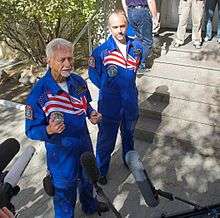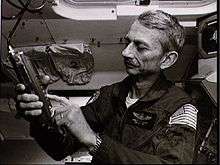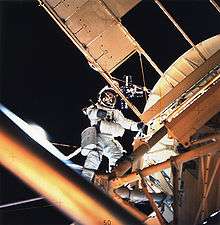Owen K. Garriott
| Owen K. Garriott | |
|---|---|
 | |
| NASA Astronaut | |
| Nationality | American |
| Status | Retired |
| Born |
November 22, 1930 Enid, Oklahoma, U.S. |
Other names | Owen Kay Garriott |
Other occupation | Engineer |
|
University of Oklahoma, B.S. 1953 Stanford University, M.S. 1957, Ph.D. 1960 | |
Time in space | 69d 18h 56m |
| Selection | 1965 NASA Group 4 |
Total EVAs | 3 |
Total EVA time | 13 hours 43 minutes |
| Missions | Skylab 3, STS-9 |
Mission insignia |
|
| Retirement | June 1986 |
| Awards |
|
Owen Kay Garriott (born November 22, 1930) is an American electrical engineer and former NASA astronaut, who spent 60 days aboard the Skylab space station in 1973 during the Skylab 3 mission, and 10 days aboard Spacelab-1 on a Space Shuttle mission in 1983.
He is the father of Robert Garriott and fellow spacefarer Richard Garriott,[1] with whom he helped found Origin Systems.
He is the co-founder and current president of Immunotherapeutics, Inc. in Huntsville, Alabama.
Biography
Education and military career
Garriott was born in Enid, Oklahoma, on November 22, 1930. He graduated from Enid High School in 1948; received a Bachelor of Science degree in Electrical Engineering from the University of Oklahoma in 1953, where he was a member of Phi Kappa Psi Fraternity, and a Master of Science and Ph.D. degrees from Stanford University in Electrical Engineering in 1957 and 1960, respectively. Garriott was presented an Honorary Doctorate of Science from Phillips University in 1973. He completed a one-year U.S. Air Force Pilot Training Program in 1966, receiving qualification as pilot in jet aircraft.
He was a Boy Scout and he earned the rank of Star Scout.[2]
Garriott served as electronics officer in the United States Navy from 1953 to 1956. From 1961 through 1965 he was an assistant professor, then associate professor in the Department of Electrical Engineering at Stanford University. He performed research and led graduate studies in ionospheric physics after obtaining his doctorate, and authored or co-authored more than 45 scientific papers, chapters and one book, principally in areas of the physical sciences.[1]
He has logged over 5,000 hours flying time, including over 2,900 hours in jet aircraft, and the remainder in spacecraft, light aircraft and helicopters.
NASA career
In 1965, Garriott was one of the six scientist-astronauts selected by NASA. His first spaceflight, the Skylab 3 mission in 1973, set a world record for duration of approximately 60 days, more than double the previous record. Extensive experiments were conducted of the Sun, of Earth resources and in various life sciences relating to human adaptation to weightlessness.
His second space flight was aboard STS-9 (Spacelab-1) in 1983, a multidisciplinary and international mission of 10 days aboard Space Shuttle Columbia. Over 70 separate experiments in six different disciplines were conducted, primarily to demonstrate the suitability of Spacelab for research in all these areas. He operated the world's first amateur radio station from space, W5LFL, which expanded into an important activity on dozens of shuttle flights, Space Station Mir and the International Space Station, with scores of astronauts and cosmonauts participating.
Between these missions, Garriott received a NASA fellowship for in the Space Station Project Office. In this position he worked closely with the external scientific communities and advised the project manager concerning the scientific suitability of the space station design.
The Skylab "Stowaway" Prank
On September 10, 1973, controllers in Houston were startled to hear a woman's voice beaming down from Skylab. Using a sexy tone of voice and calling startled capsule communicator (CAPCOM) Bob Crippen by name, the woman explained: "The boys haven't had a home-cooked meal in so long I thought I'd bring one up." After several minutes in which she described forest fires seen from space and the beautiful sunrise, the woman said: "Oh oh. I have to cut off now. I think the boys are floating up here toward the command module and I'm not supposed to be talking to you." As the Skylab crew subsequently revealed, Garriott had recorded his wife Helen during a private radio transmission the night before.[3][4]
Post-NASA career
After leaving NASA in June 1986, Garriott consulted for various aerospace companies and served as a member of several NASA and National Research Council Committees.
From January 1988 until May 1993, he was Vice President of space programs at Teledyne Brown Engineering. This division, which grew to over 1,000 people, provided payload integration for all Spacelab projects at the Marshall Space Flight Center and had a substantial role in the development of the U.S. laboratory for the International Space Station.
Garriott has devoted time to several charitable activities in his hometown, including the Enid (Okla.) Arts and Sciences Foundation of which he was a co-founder in 1992 and was co-founder of Leonardo's Discovery Warehouse (the other founder was his first wife Helen) in 1995. More recently, he accepted a position as adjunct professor in the Laboratory for Structural Biology at the University of Alabama in Huntsville and has participated in research activities there involving new microbes he returned from extreme environments such as very alkaline lakes and deep sea hydrothermal vents. Hyperthermophiles were returned from several dives in Russian MIR submersibles to the Rainbow Vents at a depth of 2,300 meters near the Azores in the central Atlantic Ocean. Other research activities included three trips to Antarctica from which 20 meteorites were returned for laboratory study. Garriott formed a 501c-3 public philanthropic Garriott Family Foundation to finance the aforementioned adventure travel for himself, his wife and other members of his family.
Family

Garriott was married to former Helen Mary Walker and they had four children: Randall O. (born March 29, 1955), Robert K. (born December 7, 1956), Richard A. (born July 4, 1961) and Linda S. (born September 6, 1966). Garriott is the father of Richard Garriott, a computer programmer and the creator of the Ultima computer game series. They eventually divorced, and Garriott later married Evelyn (Eve) L. Garriott from Huntsville, Alabama. Owen K. Garriott appears in Ultima II, apparently looking for a rocket. The shipwright character Owen from Ultima VII is named after him. Richard Garriott was launched as a space tourist aboard Soyuz TMA-13 on October 12, 2008, the first American and the second person worldwide to follow a parent into space.[5] Owen Garriott was at the Baikonur Cosmodrome in Kazakhstan for the launch of his son and was in attendance when a Soyuz capsule returned with his son 12 days later.
Organizations
Garriott is a member of the following organizations: American Astronautical Society (fellow), American Institute of Aeronautics and Astronautics (associate fellow), Institute of Electrical and Electronic Engineers, Tau Beta Pi, Sigma Xi, the International Scientific Radio Union (URSI), American Geophysical Union, American Association for the Advancement of Science, Association of Space Explorers (Board of Directors), Astronaut Scholarship Foundation (Vice President and Vice Chairman).

Awards and honors
Garriott has received the following honors: National Science Foundation Fellowship, 1960–61; Honorary Doctorate of Science, Phillips University (Enid, Okla.), 1973; NASA Distinguished Service Medal, 1973; Collier Trophy for 1973; Fédération Aéronautique Internationale V. M. Komarov Diploma for 1973; Dr. Robert H. Goddard Memorial Trophy for 1975; NASA Space Flight Medal, 1983; and additional awards related to his space flights, including the Oklahoma Hall of Fame (1980), Oklahoma Air and Space Hall of Fame (1980), the U.S. Astronaut Hall of Fame (1997), the Oklahoma Military Hall of Fame (2000) and Enid Public Schools Hall of Fame (2001).
A street named after him in Enid, Oklahoma serves as one of the city's main thoroughfares.
As the first amateur radio operator to operate from space, Garriott and fellow pioneering astronaut ham Tony England were honored with a Special Achievement Award from the Dayton Hamvention in 2002.
Books
Garriott is co-author, with fellow astronaut Joseph P. Kerwin and writer David Hitt, of Homesteading Space, a history of the Skylab program, published in 2008.
He is co-author of Introduction to Ionospheric Physics with Henry Rishbeth.
Garriott was also a contributor to the book NASA's Scientist-Astronauts by David Shayler and Colin Burgess.
Notes
The text of this article is based on his biography from NASA, dated August 2002.
Physical description
- Weight: 140 lb (64 kg)
- Height: 5 ft 9 in (1.75 m)
- Hair: Brown
- Eyes: Blue[6]
See also
References
- 1 2 Wade, M. "Garriott". Astronautix.
- ↑ Owen K. Garriott at scouting.org
- ↑ Associated Press release, as carried in the Deseret News, 11 September 1973, p. 8A
- ↑ Skylab, Our First Space Station - Leland F. Belew, Scientific Technical Information Office National Aeronautics and Space Administration, 1977, page 118
- ↑ Former Astronaut's Son Signs on as Next Space Tourist | Space.Com>
- ↑ Owen K. Garriott's physical description
External links
| Wikimedia Commons has media related to Owen Garriott. |
- Garriott's official NASA biography
- Astronautix biography of Owen K. Garriott
- Spacefacts biography of Owen K. Garriott
- Garriott at Spaceacts
- Owen K. Garriott at the Internet Movie Database
- Official publisher website for Homesteading Space
- About Owen K. Garriott
- Garriott at Encyclopedia of Science
- Encyclopedia of Oklahoma History and Culture - Garriott, Owen

